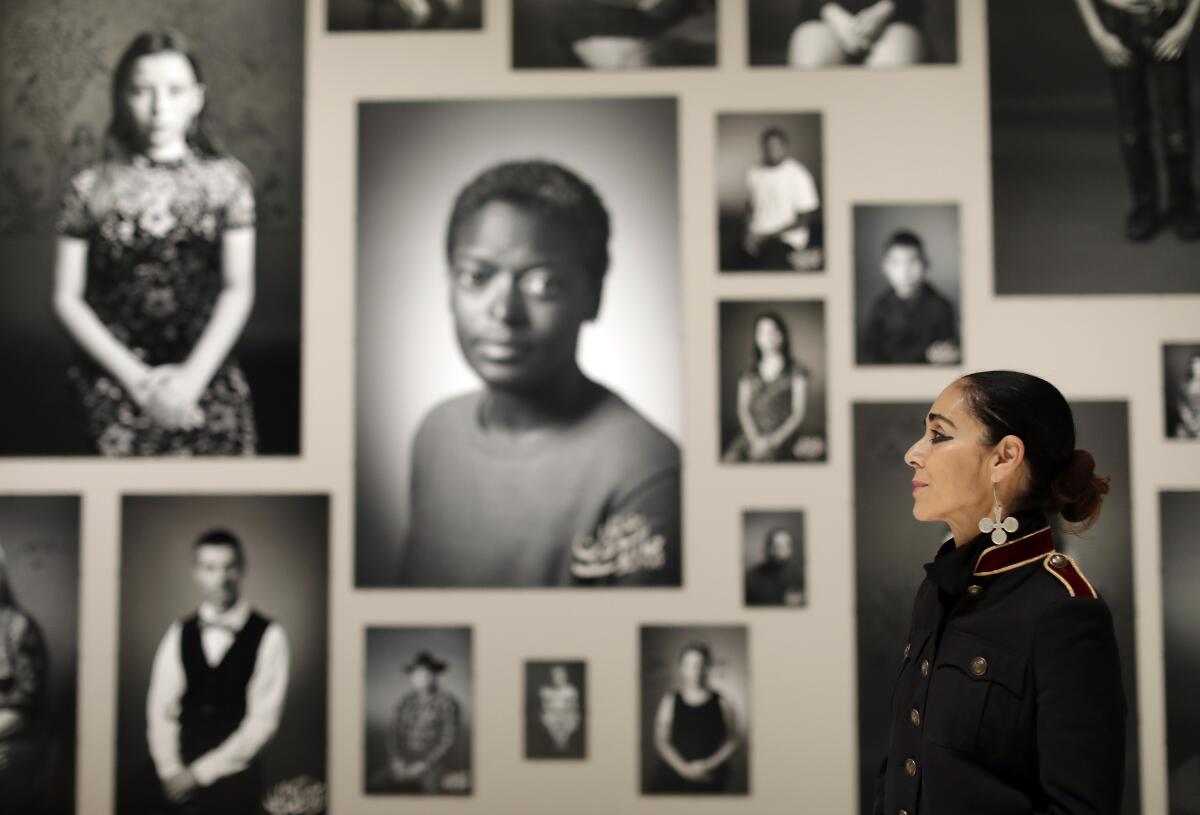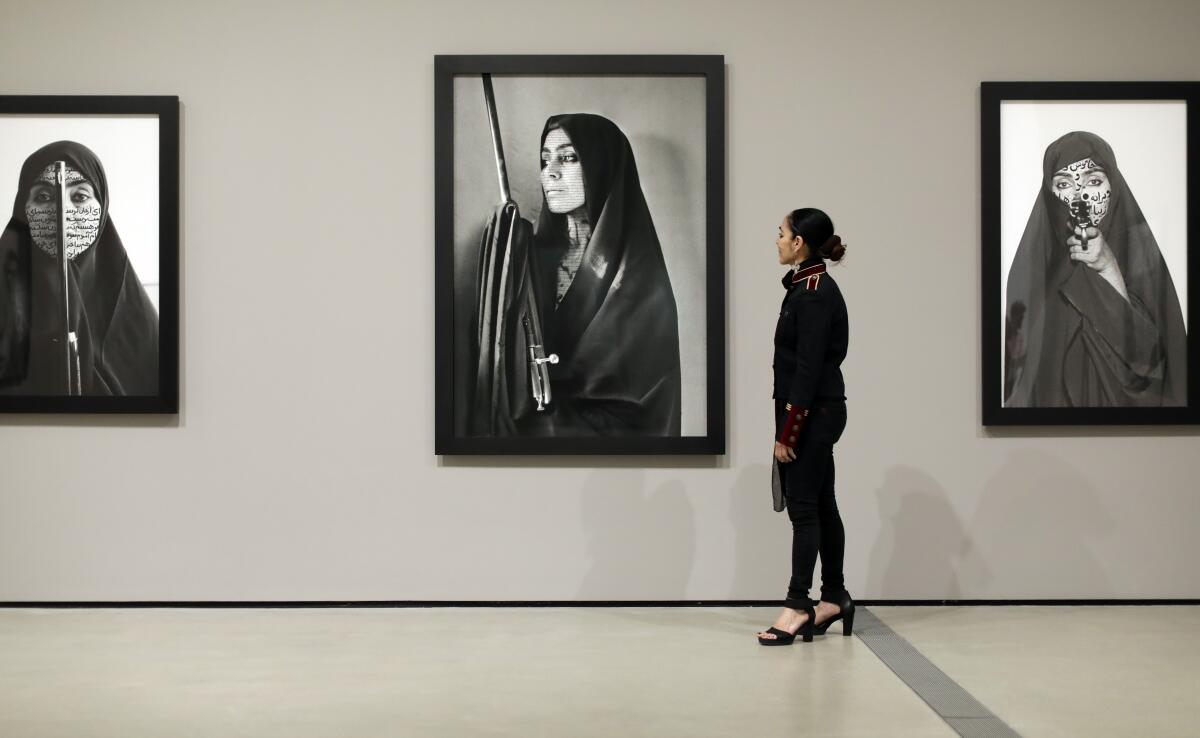Artist Shirin Neshat challenges the idea of Muslim women as victims and explores exile

A young woman emerges from a mountain in New Mexico, clambers into an old Mercedes and tools through the high desert in search of dreams. They are the dreams of ordinary people. Dreams about apocalypse, loss and salvation. Dreams that the young woman dutifully compiles into dossiers, then takes back to a strange bureaucracy obscured deep within the mountain’s folds.
The surreal tale is the latest video installation from artist Shirin Neshat, currently the subject of a one-woman show at the Broad museum titled “I Will Greet the Sun Again.” It is the largest exhibition to date for the New York-based artist, who over more than three decades has produced sumptuous films and photographs that explore the nature of political conflict, personal longing, power and exile.
They are works inspired by her own condition: Iranian, an emigré, a woman — someone who found her life turned upside down by the currents of history.
Neshat, who was born in the medieval capital of Qazvin in northern Iran, came to the U.S. at age 17 as a student in 1975, first at University High School in West L.A. and then U.C. Berkeley, at the behest of her father. Four years later, she found herself unmoored from family and country when the Iranian Revolution toppled the monarchy of Mohammed Reza Shah Pahlavi, and in its place installed a theocracy led by Ayatollah Ruhollah Khomeini.
She wouldn’t see her family again for almost a dozen years.
“All of these things made their way into my work: fear, vulnerability, being an outcast,” says Neshat, now 62, as she breezes through the Broad’s galleries in the chaotic days before her show’s opening. “Every woman in my film is an outcast, they are rebellious, they are running away.”
Despite her undergraduate and graduate studies in art at Berkeley, Neshat didn’t begin making art in earnest until the 1990s — after she returned to Iran for the first time in 15 years following the conclusion of the devastating Iran-Iraq War in 1988.
“I was so happy to go back,” she says. “But when I arrived it was a shocker. ... The country turned almost black and white.”
That trip ignited in Neshat a renewed interest in engaging Iranian culture, in particular the complicated status of women.
“Women of Allah,” her first photographic series, features chador-clad women bearing weapons inspired by the Iranian women called to arms during the Iran-Iraq War — women who functioned both as symbols of liberation and submission. The works went beyond visual impact: Neshat laced the surfaces of the images with calligraphic poems by poets such as Forugh Farrokhzad that explored themes of feminine fulfillment and desire.
As her artistic profile grew, Neshat’s explorations grew more cinematic.
“Turbulent,” from 1998, for example, shows a man and a woman facing off in a pair of poignant sung performances — a work that earned Neshat the Golden Lion at the Venice Biennale in 1999. (The charismatic Shoja Azari, her partner and frequent collaborator plays the male singer.)
In the last half dozen years, the artist has turned her eye away from Iran and toward other locations, creating work in Azerbaijan, Mexico and Egypt — including an experimental film inspired by the legendary Egyptian songstress Umm Kulthum.
“There is this really powerful moment we try to capture,” says the exhibition’s curator Ed Schad of the shift in Neshat’s career. “She starts to think, in the face of crisis, what do various cultures share? Are there symbols that designate sanctuary? Places you go to flee from harm? Things that you look to protect you in moments of emergency?”
It was that instinct that ultimately led her to New Mexico earlier this spring to shoot “Land of Dreams,” the surreal tale that is making its debut in her show at the Broad.
Looking stylish in kohl-rimmed eyes and a navy jacket with epaulets, Neshat took time to discuss her work, how it has shifted over time, and why it was time to let Iran go.
You spent your career making art that engaged Iranian themes, then in 2012 you created “Book of Kings,” a photo installation partly inspired by the Arab Spring. Why the switch?
I reached a point of exhaustion of nostalgia — of always making work about a country I can never enter. After “Book of Kings,” you begin to see me looking into other nations as an outsider going in. “The Home of My Eyes” is about Azerbaijan. I made a movie about an Egyptian singer — Umm Kulthum. What remains constant is me and I’m Iranian, so the point of view is Iranian. But I don’t have to go on forever creating this sense of memory and clinging to something that doesn’t want me back. It’s about accepting this nomadism in my life.
In “Land of Dreams,” you turn your attention to the United States.
I’ve felt uncomfortable making work about this country even though I’ve lived here longer than in my own country. I’ve always felt like an outsider. When I did “Land of Dreams,” it was a moment when immigrants started to feel cornered. I wanted to think about the idea of being an immigrant.
All of my earlier work — “Women of Allah” and “Book of Kings” — are politically charged. And the discourse around those was reduced to that political discussion. But I had started to gravitate to magical realism, then to dreams themselves. Dreams are innocent. You can kill a person in a dream, but it’s just a dream. Dreams have references to reality but they are not real. We dream regardless of where we come from. Our nightmares are common: fear of abandonment, death.
Me as an immigrant going to New Mexico — I started to feel I had so much in common with these people. We are all foreigners inside a country we call home.
What kept you artistically linked with Iran for so long?
I left when I was young without my choice. I found myself in Los Angeles alone without my family — and it was devastating for me. Then I went to Berkeley, which had a lot of anti-Iranian sentiment. I desperately wanted to go home but couldn’t go back. I didn’t see my family for 11 years. Without being overly melodramatic, the relationship with my family and my country became unresolved.
I went back to Iran in 1990 and everything fused together. It was becoming an artist again, being with family, being more mature as a human being. I had suffered a lot and I was like, no, I won’t let go of what I’ve gained. I wouldn’t allow this disconnect to happen again.
[After 1996], I was not able to go back and the relationship to Iran changed, but I created a new Iran inside New York. We have this family of friends. We are a tribe. There are like 15 of us who do this, who make these films together. We have created this community — and the unresolved, I think it became more resolved.
You didn’t make art for the first 10 years after you got out of graduate school at Berkeley. Did becoming an artist later in life change the nature of your work?
I didn’t come to art for a career. It was an accident. I went to art when I had the maturity to be an artist, when I knew I had something to say. I talk to young artists and I say, watch out for art schools. Art is a reflection of what you gain in life — from the pains in life. I’m not saying everyone’s work should be autobiographical. But there should be a mental preparation, a maturity. The only reason I became an artist was the urgency of my life experiences. The work I make comes out of urgency.
How did your early experiences in Los Angeles shape you?
I hated it. [Laughs.] Can I say that? We in Iran, we fantasized about America as if everything was Hollywood. We imagined Los Angeles as this image of perfection. I arrived and we were students and we didn’t have much money. (My sister and I came together.) We lived in ugly apartments and I remember I was terrified. I didn’t speak a word of English. When I was brought to high school on that first day, I wanted to run away.
I lived with a French Jewish family taking care of their child. I got house and board in exchange and they took care of me. (They’re coming to the opening.) My sister had to go back. My father came for a visit and I begged him to take me back. He took me to San Francisco to show me how great America is and I cried and cried. And then they left me and went home.
By the time I got to Berkeley, the revolution had happened and I was caught off guard. The money my parents were sending me stopped. The borders closed and I had to support myself. There was no communication with Iran. This was also at the time that the hostages were taken and a lot of Iranian students went back — they had gone back during the revolution. And a lot of them died and were killed. [Khomeini was killing intellectuals and students.] And here there were these protests against Iranians and I was Iranian. Those were difficult years.
We are at another moment of inflamed rhetoric against Iran. How do you contend with that?
It’s unbelievable these two countries haven’t been able to reconcile. That goes back to 1953. Iranians have never been able to trust Americans again after they overthrew their democratically elected prime minister [Mohammad Mossadegh]. Most Americans are oblivious that the Islamic revolution was a reaction to what happened after the 1953 coup. The rage, the anger that came from the Iranian community, when they found out what the CIA did — the anti-Western sentiment, it was not just in the clergy, it was among intellectuals. Now with Trump, it’s a very interesting thing to look at the history of tension with Iran.
It’s interesting to look at [my] show and see how it references some of those periods. If you look [closely], you see politics and poetry. That defines Iranians: people who have endured horrible tyranny, dictatorship, from ancient to modern or contemporary, but have this amazing imagination. The identity of Iranian people can be defined by terrible politics and amazing imagination in poetry.
In interviews, you’ve frequently challenged the idea of Muslim women as victims.
I’m so glad you brought that up. One of the things I battle with in the Western media is that no matter my work — whether the woman is protesting, is rebellious, is breaking the norms, whether it’s through a state of madness or walking out, they have stood up against the system. Yes, there are oppressions, but women have stood up. The biggest fighters in Iran today are the women. The most unafraid people in Iran are women. I’ve always tried to say that.
It’s celebrating different forms of feminisms. It’s not trying to be like men, but creating an authentic voice that is strong and confrontational. My mother was the person in control in my household, and in my life, I’m the boss.

What part of you do you see as Iranian? And what part is American?
My emotions are Iranian. There is a melancholy. I think my emotional response to art, to places, to everything, it’s Iranian. I cry easily with Persian music, Arabic music — in a way that nothing Western touches me. But the thing that is very Western is my independence. If they say, “You can’t.” I’m like, “F-— you. I’m going to do it.”
Shirin Neshat: "I Will Greet the Sun Again"
More to Read
The biggest entertainment stories
Get our big stories about Hollywood, film, television, music, arts, culture and more right in your inbox as soon as they publish.
You may occasionally receive promotional content from the Los Angeles Times.







